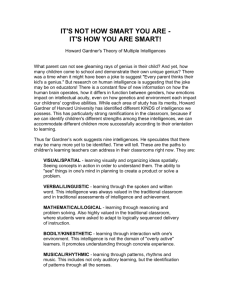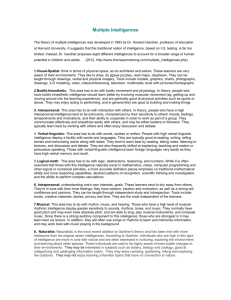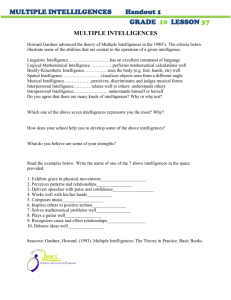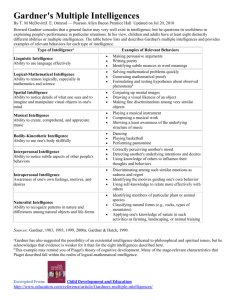Changing Minds: Book Synopsis & Review | Psychology
advertisement
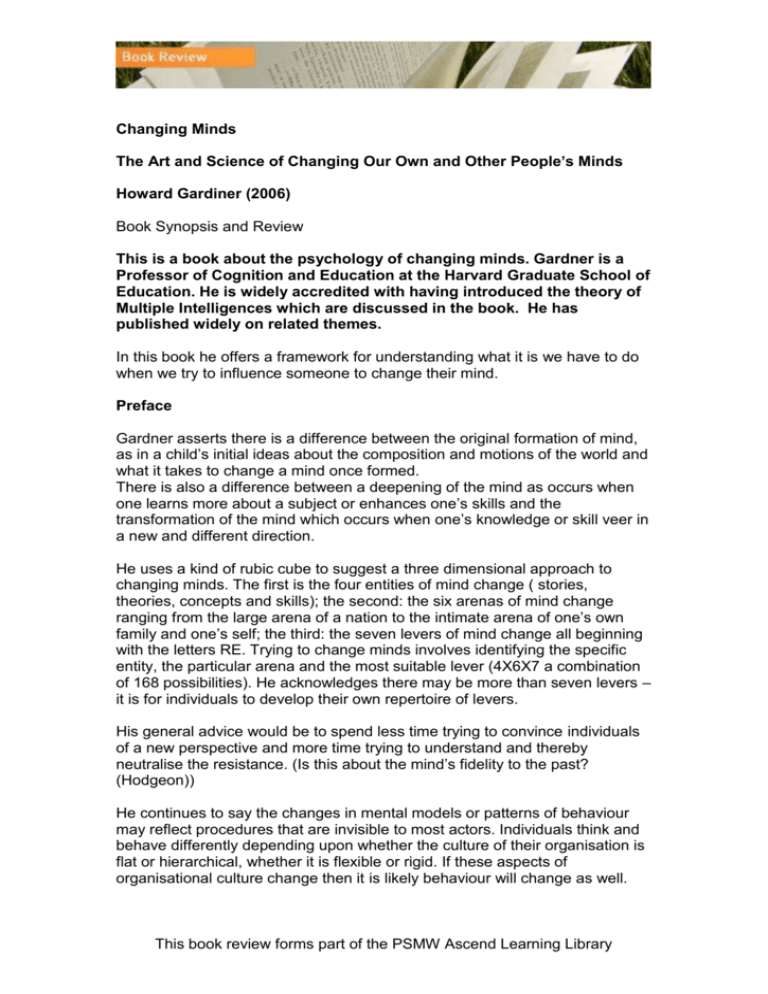
Changing Minds The Art and Science of Changing Our Own and Other People’s Minds Howard Gardiner (2006) Book Synopsis and Review This is a book about the psychology of changing minds. Gardner is a Professor of Cognition and Education at the Harvard Graduate School of Education. He is widely accredited with having introduced the theory of Multiple Intelligences which are discussed in the book. He has published widely on related themes. In this book he offers a framework for understanding what it is we have to do when we try to influence someone to change their mind. Preface Gardner asserts there is a difference between the original formation of mind, as in a child’s initial ideas about the composition and motions of the world and what it takes to change a mind once formed. There is also a difference between a deepening of the mind as occurs when one learns more about a subject or enhances one’s skills and the transformation of the mind which occurs when one’s knowledge or skill veer in a new and different direction. He uses a kind of rubic cube to suggest a three dimensional approach to changing minds. The first is the four entities of mind change ( stories, theories, concepts and skills); the second: the six arenas of mind change ranging from the large arena of a nation to the intimate arena of one’s own family and one’s self; the third: the seven levers of mind change all beginning with the letters RE. Trying to change minds involves identifying the specific entity, the particular arena and the most suitable lever (4X6X7 a combination of 168 possibilities). He acknowledges there may be more than seven levers – it is for individuals to develop their own repertoire of levers. His general advice would be to spend less time trying to convince individuals of a new perspective and more time trying to understand and thereby neutralise the resistance. (Is this about the mind’s fidelity to the past? (Hodgeon)) He continues to say the changes in mental models or patterns of behaviour may reflect procedures that are invisible to most actors. Individuals think and behave differently depending upon whether the culture of their organisation is flat or hierarchical, whether it is flexible or rigid. If these aspects of organisational culture change then it is likely behaviour will change as well. This book review forms part of the PSMW Ascend Learning Library This suggests that culture has a significant role in changing minds and that the forces of change be imperceptible. In the book he concludes with a reference to wetware (the brain), dryware (artificial intelligence and computer technology) and goodware which is about changing minds in the future for the better. In the case of the latter he discusses the importance of trust. Much of one’s capacity to change the minds of others hinges on whether or not one is trusted, seen as trustworthy, deemed to be a trustee (concerned with the future wellbeing of society). If this were to be articulated as a lever it would fall within the aegis of resonance. Chapter 1 The Contents of the Mind Minds are inevitably difficult to change but so many aspects of our lives are driven towards it. However the majority of changes are fairly trivial, where shall we eat what shall we do or wear etc. etc. Profound mind change is often more difficult to detect and contrary to the belief that it occurs following some kind of epiphany it is often the result of a slow almost unidentifiable shift in view point. Although it might appear as sudden, reflecting a dramatic eruption in consciousness it has often been developing gently over a lengthy period of time. A key to changing minds is to produce a shift in the individual’s mental representations which is the particular way a person perceives, codes retains and accesses information. Gardiner uses the example of Pareto’s 80/20 rule that fundamentally challenges our view of everything as proportionate, equally distributed and causally related. Mental representations have a content and a form or format. The content is the basic idea contained in the representation. The form or format is the particular language or system of symbols or notation in which the content is presented. Using different formats to express different versions of the content is an extremely useful way of changing minds. The Seven Levers (Re’s) Reason A rational approach involving the identification of relevant factors, weighing each in turn and making an overall assessment. It can involve sheer logic, the use of analogies or the creation of taxonomies. Research Complementing the use of argument this involves the collection of relevant data. It can occur formally or informally. Resonance This appeals to the affective element of the human mind. A view perspective or idea resonates to the extent that it feels right, seems to fit the current situation and convinces the individual that all other arguments are This book review forms part of the PSMW Ascend Learning Library superfluous. It often comes about because one feels a relation to a mindchanger finds that person reliable or respects then. Representational Redescriptions The argument becomes convincing when represented in a number of different forms, all of which reinforce one another. The more ways in which a case for change can be represented the more likely it is to be accepted Resources and Rewards Change is likely to occur when considerable resources can be drawn upon to reward individuals for one individual behaviour over another. Real World Events Sometimes, an event occurs in the broader society that affects many individuals not just those who are contemplating a mind change e.g. wars hurricanes, terrorist attacks, economic recessions. Resistances It is easier to change the mind of someone who is young. As people get older they develop and retain stronger views and ideas that are often resistant to change. Changing minds isn’t just about facilitating the positive but also addressing the negative. Gardiner’s six arenas one of the two other dimensions to be addressed when changing minds includes: 1. Large scale changes involving heterogeneous groups such as the entire Nation; 2. Large scale changes involving a more homogeneous group such as the health service or local government; 3. Changes brought about through works of art, science or scholarship, such as Einstein, Marx, Darwin, Picasso etc.; 4. Changes within formal instructional settings such as schools 5. Intimate forms of mind changing involving two people or a small number such as a family; 6. Changes within one’s own mind Gardiner’s entities, the third element or dimension of changing minds includes: 1. Concepts – an umbrella terms that refers to any set of closely related entities e.g. civilisation, democracy, winter etc; 2. Stories - narrative describing events that unfold over time; 3. Theories – relatively formal explanations of processes in the world; 4. Skills – that which individuals are capable of doing. Stories and theories are by their nature propositional while skills consist of procedures that individuals know how to carry out. Applying the principle of form and content to skills is less easy to do because they are co-dependent. This book review forms part of the PSMW Ascend Learning Library Such as W.B.Yeats famous query, ‘How can one tell the dance from the dancer?’ For Gardiner these are the major kinds of content that inhabit the human mind. As entities we must work through them in order to change minds. Chapter 2 The Forms of the Mind Gardner defines intelligence as a biopsychological potential to process specific forms of information in certain kinds of ways. This underpins his theory of multiple intelligences which suggest the more intelligences you can appeal to when seeking to influence and change the mind of someone else the more likely you will be successful. The important point to remember is that these intelligences are not equally proportioned within an individual. They can vary significantly accounting for the fact that some individuals are very bright in relation to particular kinds of knowledge and less so in relation to others. The intelligences he has identified are as follows: Linguistic intelligence This is about the ability to use spoken and written language. Individuals who posses this may be good at writing or learning other languages, presenting or using language effectively. Logical-mathematical intelligence As suggested in the title this is about scientific and numerical skills. Musical intelligence The ability to appreciate and produce music, almost like a kind of linguistic intelligence. Spacial intelligence The capacity to form special representations or images in one’s mind and to operate upon them variously. Bodily-Kinesthetic intelligence The capacity to solve problems or create solutions using one’s whole body ie hands or mouth – (someone good with their hands). Naturalist Intelligence The capacity to make consequential discriminations in the natural world ie between one plant or animal and another. What is fairly evident is that the first three are systems of intelligence that work with symbols and codes. The latter are primarily concerned with material objects. Both categories involve concepts, stories, theories and skills. But proportionally, the latter three are more to do with skills and the former with concepts, theories and stories. This book review forms part of the PSMW Ascend Learning Library Gardner goes on to speak of a third group of intelligences called interpersonal intelligence externally focused upon other people and intrapersonal intelligence which broadly translates into self-knowledge. These two kinds of intelligence we would regard as emotional intelligence. ‘ We come to know ourselves by making use of the distinctions involved in coming to know others.’ (Page 39) Finally he identifies existential intelligence this is about the human capacity to pose and ponder the big questions who are we? why are we here? What is it all about? Chapter 3 The power of early theories -Using the development theories of Piaget, Gardner suggests that we learn to theorise at a very early age and that these in turn become difficult to alter or reshape in adulthood. We don’t theorise to be correct but to connect. We try to connect by making sense of the world but it doesn’t mean that we are right. We consequently presence ourselves within conversation with others where we articulate our theories. All theories have surface plausibility about them but regardless of their value they tend to endure. To evidence his case Gardner provides a taxonomy of theories that we are prone to making (Page 55) Factors that impel changes of mind Often we are impelled towards mind change when confronted by alternative views that are powerful and rich in information. Vygotsky advocated finding the current extent and weight of a persons mental representations before trying to substitute them fro others. In relation to children Vygotsky suggested that poor performance can be significantly improved by proving scaffolding- the orderly provision of just enough support. Successful scaffolding is internalised eventually becoming part of the architecture of the way a person thinks. Chapter 4 Leading a Diverse population To Change minds effectively leaders make particular reference to two tools; the stories they tell and the lives they lead. In terms of the levers they use for change the resonance between the stories they tell and the ay the conduct their lives is highly important. Garners cites the likes of Mahatma Ghandi, Margaret Thatcher and Bill Clinton as examples of this. New stories will supplant old stories drawing upon all the levers of mind change to succeed. In addition to its conscious appeal a story must be able to capture an audience at a deeper more visceral level. This book review forms part of the PSMW Ascend Learning Library Chapter 5 Leading and Institution: How to deal with a Uniform Population Gardner uses this chapter to provide an example of changing minds using each of the levers at an American Educational Institution. He concludes by suggesting that Leaders draw upon intellectual, instinctual and moral resources to be successful. In his view successful leaders generally exhibit three intelligences. Firstly, as storytellers they must be gifted linguistically. Leaders require significant interpersonal intelligence (emotional intelligence). Thirdly they require existential intelligence. They need to be comfortable with posing significant questions. Chapter Six Changing Minds Indirectly – through scientific discoveries, scholarly breakthroughs and artistic creation In this chapter Gardner uses the examples of Marx, Einstein and Picasso to demonstrate how new thinking can be facilitated in others. He articulates the case that often people are tied to old ways of thinking and doing so new theory must draw upon all the levers to provide a successful challenge. He draws the conclusion that later borns are statistically more likely to embrace change than first borns. Chapter 7 Mind Changing in a Formal Setting Gardner offers a brief history of school education to illustrate the mind changing properties of early education. He suggests that the key lever to mind change in these circumstances is through representational redescription. To do this successfully one must engage in one or more of the following activities to factor in the theory of multiple intelligences: Narrative (telling stories about the issue) Quantitative (using examples connected to the topic) Logic (identifying key elements and exploring their logical connections) Existential (addressing big questions such as the nature of truth) Aesthetic ( examining instances in terms of their artistic properties) Hand-on (working directly with tangible examples) Cooperative or social (engaging in projects with others) Chapter 8 Mind Changing Up This book review forms part of the PSMW Ascend Learning Library At this point in the text Gardiner reminds us that it dangerous to make the assumption that mind change is about the acquisition of knowledge and that the more knowledge we give to people the more likely they are to be opened minded and change. This is not the case. It is clearly evident that individuals will not be influenced by the same thing or for the same reasons. If we hope to be successful in changing the mind of a particular person it is vital to find out about her traits, dispositions, scripts and favoured mental representations. Some must be deduced before hand and some during the encounter, requiring the influencer to be truly present. In order to resonate fully with the individual to be influenced Gardner recommends the following considerations which he suggests operate a on a continuum rather than a binary framework: Argument, facts, rhetoric. Is the person moved chiefly by argument and logic, facts and oratorical endeavour? Central versus peripheral routes. Is the person more likely to be engaged by a direct discussion of the issue? Consistency. How concerned is the person with consistency? Stance on conflict: how much is the person bother by the give and take of argument? Emotional charged territory: What are the issues and ideas about which the person feels strongly? Current scripts – content: On any topic the conversants will have certain scripts or mental representations that are more of less well consolidated. What are the scripts and how strong do they adhere to them. Current scripts – form: when demonstrating the argument does the individual like graphics text statistics pictures or stories. For Gardner, the most important thing is to avoid geocentricism – becoming ensnared in one’s own construal of events. The purpose of mind changing encounter is not to articulate ones own point of view but rather to engage the psyche of the other person. Chapter 9 Changing one’s own mind All seven levers of mind change can play a role in changing our own minds as well as that of others. Chapter 10 Epilogue: The Future of Mind Changing Recap for those who have not been paying attention Generally mind change involves the alteration of mental representations. We develop these from the beginning of life. Mental representations have This book review forms part of the PSMW Ascend Learning Library a content – ideas, concept, skills or stories or fully fledged theories (explanations of the world). These contents are expressed in a variety of forms media or symbolic systems (writing, mathematics art etc). We use 7 levers to engage with individuals who we want to influence and develop our strategy depending upon the context, circumstances and the audience size. Appendix A framework for analysing cases of mind changing Example: Type of idea: concept/story/theory/skill Charles Darwin’s Evolutionary revolution Theory Desired content: The mind change being sought Origin of species through natural selection over long periods of time Counter content: The idea that runs counter to the desired content Religious accounts – intuitive theories of creationism Type of audience/arena: Large/small; diverse/heterogeneous Initially small and uniform (scientific community) but eventually larger and more diverse Format: Intelligences, media symbol systems Linguistic argument in book form, corroborating evidence in fossils, flora and fauna Levers of change: The most germane of the seven levers and considerations that determine whether a tipping point is reached Reason, research, representational redescription, overcoming resistances ISBN 1-4221-0329-3 (ISBN 10) This book review forms part of the PSMW Ascend Learning Library
